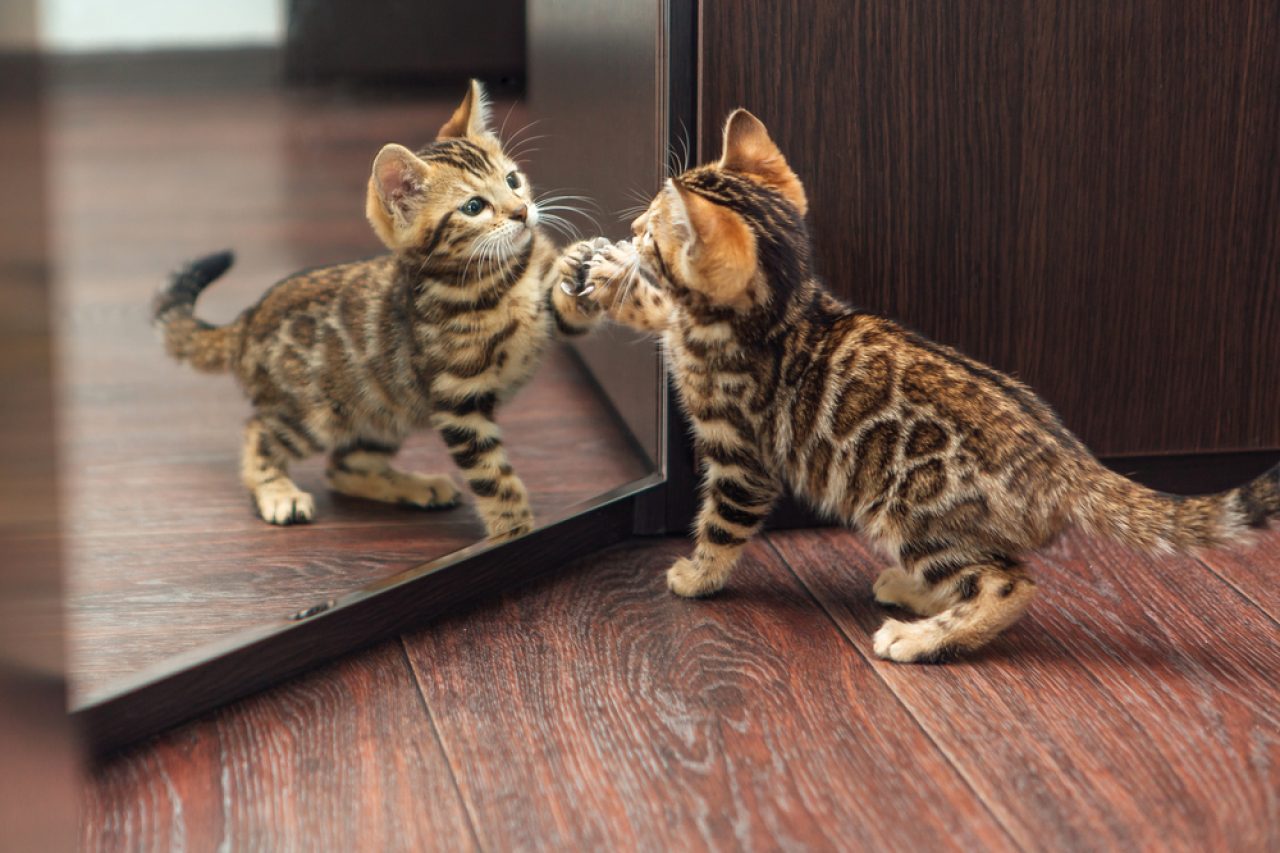📖 Table of Content:
We all know that cats are curious creatures and they’ll explore their living space thoroughly as soon as they get the chance. Since you’ve probably Googled something like “when should I let my kitten roam the house” in the hopes you’ll find some answers, let me help you.
I may not be a qualified vet who knows all the ins and outs of kitties or animals in general, but I’ve been a proud cat owner for many years, so I know a thing or two about raising one. Fostering a number of them before I actually decided to keep one, helped me connect more with these beautiful creatures.
I’d probably lie if I told you that I know her like the back of my hand, but I assure you that I can figure out what’s wrong with her in a heartbeat. We kind of built a beautiful bond and nothing compares to that, honestly.
We needed a lot of time to get used to each other, especially because she came to me as a foster cat from an abusive home. I needed to gain her trust and show her all the gentle love I have for her. Eventually, we became inseparable.
Okay, I’m not going to get all emotional now. Let’s get to the answer you’re seeking already. So, if the question of when you should let your kitten roam the house is bothering you, let’s talk about it.
When should I let my kitten roam the house?
Honestly, this question is a bit difficult to answer, not because it can’t be, but rather because every cat is unique and their adaptability to new households depends on a lot of different factors. If your feline is a bit shy and scared, it will take her a longer period of time to get used to the new place.
Perhaps, your furbaby has issues that you’ll have to deal with as mine did, and then you’ll have to gradually help her overcome each and every one of them. Or, you may have it lucky and be one of those owners whose cat is completely loving the new place and embracing the change easily.
However, there are some general guidelines you can follow to determine when you should let your kitten roam the house. One of them is soon as she’s litter box trained. Well, she has to feel comfortable as well, but this first reason will save you a lot of trouble if you pay attention to it.
Until the moment you let her wander around solo, you have to monitor your kitty, since there are some consequences if she roams on her own a bit too soon.
What could happen if I let my kitten roam the house too soon?
It’s completely natural that this question popped into your mind after I’ve mentioned consequences. None of them are deadly if that’s any consolation, but some may be pretty dangerous if you’re not attentive enough. So, let’s go through the possible consequences.
1. She may have litter box accidents
Yup, that’s right. She may be too small and have problems with climbing into the litter box. It can happen that she turns the container upside down as well. Imagine the mess she’ll leave afterward! Also, she could dig out some litter and spread it all over the place.
Another pawsibility if your furbaby isn’t entirely litter box trained yet is that she may defecate wherever she wants. Houseplants, bathroom rug, kitchen, living room couch, you name it. If she doesn’t know where she should do her business, you can expect her to do it everywhere.
2. She could get stuck in tight places
If you let your cat roam the house on her own, she may get stuck in weird and tight places. Imagine if she has some difficulties with being touched and you try to approach her, and she starts running away. She’s hiding somewhere, but you can’t find her… Sounds stressful, doesn’t it?
There are a lot of tight places where she’ll try to hide in order to feel safer, but that can easily bring her more trouble. So, next time when you ask yourself “When should I let my kitten roam the house?” always err on the side of later rather than sooner.
3. She may get lost if you have a bigger home
For those of you with bigger homes, if you let your kitty roam your house a bit too early, she could easily get lost. Imagine a huge ground floor, with a big backyard and a floor or two above it. That’s an entire labyrinth in your kitto’s eyes.
At first, her curiosity will get the best of her. She’ll go around and explore every nook and cranny of your mansion. But what happens when she decides that she’s had enough? Is she going to find you easily or will this “ameowsment” park turn into a nightmare?
4. She could hurt herself
Do you know how people make their home safe for kids once they become parents? They worry about all the sharp edges, stairs, and small objects that can be choking hazards. Will you believe me if I say it’s the same for our furbabies?
If you let your cat roam on her own around your house, she may very well hurt herself as she isn’t yet familiar with the environment and its dangers.
Do you know how they like to jump around? Every tall object automatically becomes a threat. Every sharp corner can be harmful, and every tiny thing that you drop on the floor could be potentially dangerous for her.
For these reasons, you should definitely keep monitoring her at least until she gets used to the new space.
5. She may destroy your houseplants
There will probably come a time when you’ll have to decide if you want to forgive your kitty for ruining your favorite silver vase plant. And this will happen way too often if you let her roam the house alone. I mean it when I say she’s going to explore EVERYTHING.
She’ll jump in the flowerpot just to see what’s happening over there and in no time, the soil will be all over your living room floor. Now, imagine this happening in the middle of the night and you wake up to this horror. Doesn’t sound appealing, does it?
Should I let my kitten roam the house at night?
Another question that has no concrete answer. You can let your kitten roam the house at night if you feel like your kitten is comfortable doing so on her own.
It may be a bit noisy, she may cause a couple of problems and you won’t be awake to help her, so I’d personally avoid doing this until after she’s totally fine solo-roaming during the day.
The last thing you want is her stuck somewhere, running out of breath, while you’re fast asleep in your bed. Maybe I’m a bit overly cautious because my furbaby is still young, but I like to be there for her in case she needs me, especially after everything she’s been through.
Cats belong to the group of crepuscular animals, and that means they’re mostly active at dusk and dawn. This may interfere a bit with your sleeping schedule, but if you choose this little feline as your pet, you have to be ready even to stay awake a bit longer than usual.
How can I kitten-proof the house before I let my kitten roam in it?
Once your answer to “When should I let my kitten roam the house?” is “Right now,” that’s when you’ll know you’re both ready. She’s comfortable with her litter box and familiar with the environment and household in general.
By this time, she knows all the basics and where she should and shouldn’t go, what’s dangerous and what’s not. But, you can’t be careful enough, so I’ve prepared some cat-proofing tips for you. Let me spill the (toe) beans, okay?
1. Identify all escape routes
First things first, before you let her roam the house on her own, identify all escape routes. That means balcony doors, windows, terraces – you name it. Make sure that she can’t flee if she starts feeling uncomfortable, because that may happen.
Secure those possible escape solutions and then slowly let your feline get familiar with the living space that surrounds her.
2. Put a little bell on her collar
This is something that really helped me and I bet a lot of other worried cat owners too. Little collar bells won’t make a big difference for her since they are pretty light, but you’ll be able to find her easily if she goes AWOL.
Also, you’ll know by the sound how far she is from you and if you should be worried because she stayed in the bathroom for too long. When you hear the tinkling get faster, you’ll quickly learn that your kitty’s got her paws dirty, digging in your house plants again!
3. Control the space where she can roam
In the beginning, keep her in one room. Let her get familiar with everything there before you allow her to roam around the rest of the house alone. Make sure you’ve secured all the doors and windows to this confined area and keep your feline in there.
Then gradually let her explore the rest of the house, one room at a time. Before taking this step, however, make sure that the room is kitten-proof and that there’s no way she’ll hurt herself. Which brings me to the next tip…
4. Remove objects that could hurt her
This is very important to do before you let your kitten roam the room and eventually the rest of the house. Vacuum everything, and make sure that there are no little particles that could be a choking hazard. You can also install child-proof locks on cabinet doors. That way, she won’t be able to open and explore them.
Read about poisonous plants and foods for cats (for example, lilies, tulips, aloe vera, garlic, and onion) and either put them safely out of her reach or remove them completely from your home.
5. Introduce her to other members of the household
The last step that you should take before letting your kitten roam the house would be to introduce her to the other members of the household she just joined. This may not be an easy task if you have more pets or small children because it will take some time for them to get used to one another.
However, insist on building that unbreakable bond between them and make sure your kitty knows every creature living in the same space, whether it’s human, pet, or plant. That will help her feel more comfortable and relaxed in the new environment and you’ll have fewer problems later on.
In the end, it’s completely your choice about when you should let your kitten roam the house. Firstly because you know her the best, and secondly, because each kitty is a uniquely magical creature. So, enjoy spending time with your furbaby and listen to her needs.
Create a beautiful bond and everything else will fall into place. I promise you that as soon as you adopt or foster a cat, every second spent with her will be the highlight of your day. Have fun!







